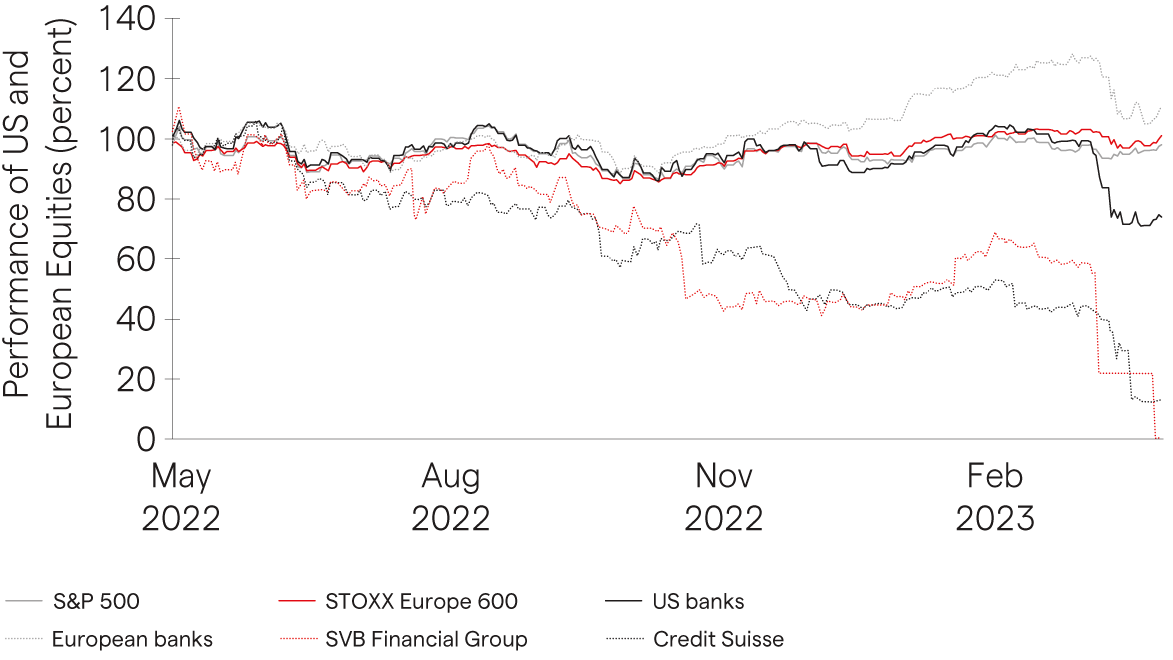Banking crisis follows familiar pattern
The March banking crisis, which prompted sharp falls in equity and bond markets, followed a pattern familiar to anyone with even a passing knowledge of previous periods of turbulence in the global financial system. The failure of regional banks in the US and the demise of Credit Suisse in Europe exposed regulatory failures and poor risk management, and the collapses were triggered by a prolonged and significant increase in interest rates. That mirrors how the 2008 global financial crisis unfolded.
Banking turmoil jolts financial markets

Moreover, further tremors – or worse – could yet follow. Lucrezia Reichlin, professor of economics at the London Business School, for example, recently told the International Monetary Fund (IMF) that she expects other banking crises to happen – especially if central banks continue to tighten monetary policy. She explained that ‘banking crises cannot be prevented in all contingencies, at least not in a fractional reserve system where loans don’t need to be fully backed by deposits, like the system we have today’. She added that ‘the recent crisis is a painful reminder of the fundamental instability of banks’ business model’. 1
Attention switches to hedge funds, asset managers, family offices etc
Nonetheless, regulators are under pressure to act – and it looks like non-bank financial institutions, such as hedge funds, asset managers and family offices, are likely to be a key area of their measures. The Financial Stability Oversight Council in the US, for example, has proposed guidance to make it easier to designate non-bank financial institutions for regulatory supervision, together with new procedures to better identify and respond to financial-system risks.
US Treasury Secretary Janet Yellen has also raised concerns about these institutions being a potential source of financial instability because of a lack of supervision. The focus on non-banks appears perverse, given that it was banks that failed in March. However, a look at the latest IMF Global Financial Stability Report, released in April, shows just why officials are looking at other areas of the financial system.
The report concludes that banks represent a smaller portion of the global financial system than they did at the time of the 2008 financial meltdown, and that the murky area of non-banks presents a new array of financial dangers. Non-bank Financial Intermediaries (NBFIs) now account for some 50% of global financial assets, up from 40% in 2008, according to the IMF. Moreover, their use of financial leverage and exposure to illiquid assets has soared since the global financial crisis: insurance companies, one of the largest non-bank sectors, have doubled their illiquid investments over the last decade, says the IMF.
 When banks go bust: the four factors at play - trust, confidence, contagion and systemic risk
When banks go bust: the four factors at play - trust, confidence, contagion and systemic risk
The Wall Street Journal has also highlighted the opaqueness of the sector, arguing that:
‘Because nonbanks can be as different from each other as they are from banks, they defy any straightforward regulatory oversight. This thwarts efforts to gather comprehensive data on their activities.
Then, as the IMF points out, there is the growing interconnectedness of the banking and non-banking sectors.
The IMF’s report also sums up why it is non-banks that are now attracting so much attention:
‘The combination of poor market liquidity, high leverage, and a high degree of interconnectedness between NBFIs and banks is most dangerous to the financial system because it can amplify asset prices changes and spread stress to corners of the financial system that ex ante may seem to have little in common.’















